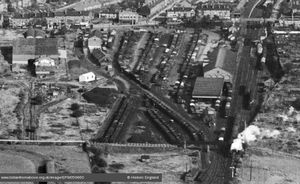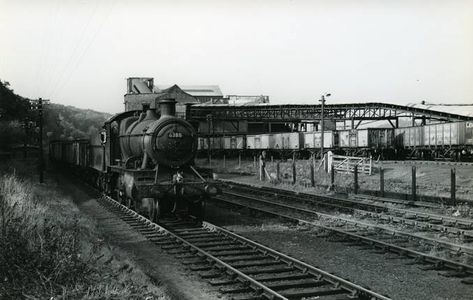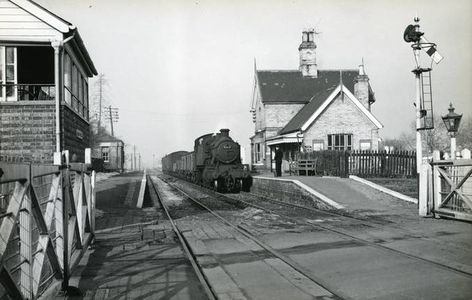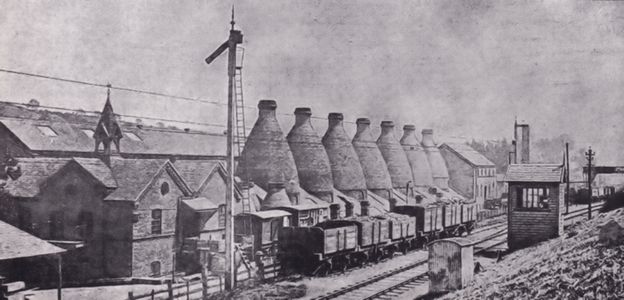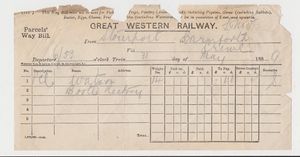Goods traffic on the SVR
During its 101 year history the Severn Valley branch was never financially successful.[1] GWR Traffic statistics for stations on the branch show that between 1903 and 1923, passengers only accounted for around 20% of the total revenue, with around 80% of the revenue arising from freight traffic. After that time passenger numbers declined, and by 1938 revenue from passenger traffic accounted for little more than 10% of the total, with freight traffic nearing 90%.
Freight traffic therefore played a major role in the history of the branch. It included coal traffic from the Collieries served by the Severn Valley Railway, goods traffic to and from the industries of the Ironbridge Gorge, and other goods traffic, mainly agricultural. This article is an attempt to piece together information on the quantity and variety of goods carried on the SVR during that time.
Contents
Colliery traffic
There were Collieries served by the Severn Valley Railway with sidings at Highley (1880s-1939), Kinlet and Billingsley (1895-1937), and Alveley (1939-1969).
After the Stourport station canal basin and interchange sidings opened in the 1880s, coal was moved by rail from Highley to the canal basin and from there to the nearby ironworks at Wilden and Stourvale via the Staffordshire & Worcestershire Canal.[2][3]
A branch line from Stourport Station to the power station opened in 1940; thereafter coal could be brought in by rail. Alveley coal trains required the use of a tender engine; initially a Kidderminster based LNER J25 during the War years and thereafter an ex-GWR 43xx Mogul.[4] During the 1950s a daily morning train would work empty from Stourport Power Station to Alveley Sidings and return fully loaded, with another round trip in the afternoon. The normal motive power at the time was GWR 6382 or another Mogul.[5]
GWR Mogul 6388 passes large numbers of coal wagons at Alveley Sidings in October 1959 (Sellick Collection)
Slack trains would also arrive from the LMS area via Great Bridge to Hartlebury from where they would reverse to Stourport, returning empty. The trains consisted of around 36 wagons with LMS brake vans at each end. These were normally worked by a GWR 56xx 0-6-2T, generally no. 6665 or 6684 from Stourbridge. In 1956 Kidderminster was allocated its own 56xx, no. 6679[4].
Daily goods train
A daily goods train would work in each direction on the Severn Valley branch.[note 1] Tony Barfield, a fireman at Kidderminster in the mid-1950s, described the northbound operation thus:
The Salop Goods was a daily through goods train from Hartlebury to Shrewsbury, calling at the stations and goods yards along the branch, picking up and putting off odd wagons, re-arranging coal wagons and cattle trucks at small yards such as Arley or Hampton Loade, sometimes doing considerable shunting at Bewdley or Bridgnorth. Loads would vary from day to day. A hard struggle to Bridgnorth with a mixed train of coal, cattle trucks, pit props, fruit vans, might be compensated by a non-stop run back with perhaps only half a dozen empties. The Salop Goods was usually worked by tender locomotives except at boiler washouts or repairs when a 41xx class 2-6-2 deputised. Moguls such as 6382, 5355, 6314, 6388 all worked at times but generally the train was worked by Collett 0-6-0 no 2207.[5]
The BR(W) 1948 working timetable gives an example of this working, which began with a 9.30am departure from Hartlebury and ended at Shrewsbury Coton Hill yard at 6.58pm. The stop at Cressage has a note in the timetable 'To deal with Cattle traffic and perform S.T. work only', the S.T. referring to the Station Truck forming part of the train.
Ex-GWR Prairie 5153 passes Cressage with a goods train on 2 March 1963 (Sellick Collection)
Sugar
The opening of the West Midlands Sugar Co (later British Sugar Corporation) factory at Foley Park sidings in 1925 began sugar beet trains to Foley Park, which ran until closure of the factory in 1982. The processing season ran from mid-September to mid-January, during which time up to four complete trains per day would arrive at Kidderminster. Tripping these loads from Kidderminster yard along the Loop line required a locomotive to be available 24 hours per day.[6]
Outside the regular beet season, the factory was kept supplied by train loads of sugar cane from Newport or Cardiff docks. Tank loads of molasses, a by-product of the refining process, were shipped from the factory to Avonmouth docks[7].
Cattle
A number of the stations on the branch had 'cattle docks' from which loaded cattle wagons could be collected. The 1936 GWR 'General Appendix to the Rule Book' stated that "In dealing with Live Stock, including horses, cattle, sheep, pigs and goats, care and patience must be shown, not only in loading and unloading, but also in their treatment during transit, and in or about the yards, pens, sheds and stations, in order to avoid fright or injury, and consequent suffering on the part of the animals."[8]
Post-War, cattle trains ran on market days as required from Bridgnorth on alternate Mondays and Tenbury on alternate Tuesdays to Bordesley via Kidderminster[9]
Bricks and tiles
A number of the brick and tile works in the Ironbridge Gorge had their own private sidings or made use of the extensive sidings at Jackfield. Maw and Co's factory opened in 1883 and became the largest tile works in the world, employing almost 400 people and producing 20 million tiles annually. They had their own privately owned railway wagons and for many years made extensive use of the Severn Valley Branch to transport almost the whole of the factory's output. The 1922 working timetable showed that it was served by the Down goods train from Hartlebury (the 'Salop Goods') arriving at 4.13pm and the Up goods from Shrewsbury arriving at 3.45pm. The siding continued in use until 1959.
Lime
The Bower Yard Lime Kilns were located north of Ironbridge. For some years the GWR brought coal to the kilns and transported the lime to various areas of the country.
Sand and gravel
There were a number of private sidings including H. Whitehouse's sidings at Kidderminster and Wilden, and those accessed via the Foley Park sidings.
When Kellett's Gravel pit at Foley Park closed in 1904, the sale included 51 ballast wagons and a 5000 ton stockpile, suggesting that many thousands of tons of ballast had been carried on the SVR on its way to Frankley, Birmingham, in the two and a half years the pit was open.[10]
Examples of references to goods traffic
Some newspaper stories make passing reference to the type and quantity of goods carried on the SVR.
- A luggage train "of considerable length" carrying sacks of bran, iron fencing and copper sheets through Tenbury on its way to Bewdley in 1864.[11]
- 1867 thefts from Bewdley goods shed included a ham; 'other articles suitable for domestic consumption'; clothing, and liquor.[12]
- Around 1867 charcoal production was a significant industry in Bewdley and the Wyre Forest. At 4am on Wednesday 15th May 1867, a wagon loaded with charcoal caught fire "through carelessness in loading it with a piece of lighted charcoal". The fire spread to the two adjacent wagons and resulted in two wagons being destroyed.[13]
- Bewdley's winter fair was by the time of opening of the branch 'becoming a good fair for sheep and cattle'. In 1870 a Mr Barnes successfully sued the LNWR for non-delivery of seven cows to the market from Northwich, via Bridgnorth.[14]
- "The timber obtained from [the Wyre Forest] is used for the most part in collieries in South Staffordshire" in 1884.[15]
- Three truck loads of hay from Newnham Bridge to London in 1885[16]
- November 10 1888, 6:30pm goods train from Tenbury due at Bewdley at 8:32 consisted of 25 loaded and three empty wagons plus a brake van with two guards.[17]
- Seven trucks of long oak timber from Bewdley to Griff Colliery, Nuneaton, August 22 1899.[18]
- "The general waiting room [at Bewdley in 1901] was usually crowded with luggage and parcels..."[19]
- An average of 2000 homing pigeons a day during one week in 1901 being sent to Kidderminster.[20]
- Sixty truck loads of cattle and sheep from Kidderminster market in 1903[21]
Bewdley Consignment Notes from 1965
A selection of consignment notes from Bewdley Station have been preserved and give an example of the type of parcels and small loads being handled at the station in 1965.
- Alton Glasshouses, 3 lbs of timber to Bradford. Image
- Alton Glasshouses, 7 lbs of timber to Littleborough, Lancs. Image
- Alton Glasshouses, 5 lbs of timber and steel to Sutton Coldfield. Image
- Alton Glasshouses, 5 lbs of steel to Northampton. Image
- Thomas' Dairy Ltd, Wribbenhall, Bewdley, box containing water meter, 2 lbs, to The Leeds Meter Co. Ltd. Image
- Catswell Farm, Wyre Forest, 31 trays of cherries, totalling over 3 cwt (150kg), to Smithfield Market, Birmingham. Image
- Charles Smith, 9 trays of cherries to Birmingham. Image
- Mr. Venables, 22 trays of cherries to Manchester. Image
- L. Parkes, Kinlet, 4 trays of cherries to Birmingham. Image
- Mr. Murray, Bliss Gate, Rock, 2 chips[note 2] of cherries to Chulmleigh, Devon. Image
- Alton Glasshouses 7 lbs of timber to Barnsley, Yorks. Image
- A fishing rod being returned to Kay & Co. Worcester.[note 3] Image
- C.J.Adam, Bewdley, 6 lbs fruit to Sheffield and 5 lbs fruit to Chester, Image
- A watering can being returned from Rhea Hall Estate to Wigan due to being damaged in transit. Image
- C.J.Adam, Bewdley, 12 lbs fruit to Rutland. Image
- C.J.Adam, Bewdley, 13 lbs fruit to Sheffield. Image
- Mr. Murray, Bliss Gate, Rock, 2 chips of cherries to Crediton, Devon. Image
- Mr. Murray, Bliss Gate, Rock, 1 chip of cherries to Lapford, Devon. Image
- Two Collico[note 4] cases being returned from a Cleobury Mortimer Chemist to Max Factor, Wembley. Image
- One basket of pigeons from Highley for release by the Station Master at Gloucester. Image
- Dowles Nurseries, near Bewdley, sending plants to Hampshire, Kent and Middlesex. Image
- Herbert C. Styles sending 2 qtr (25kg) of diet powder to a Swindon hospital. Image
- Dowles Nurseries, near Bewdley, sending plants to Leicestershire and Stratford-upon-Avon. Image
- Alton Glasshouses sending 7 lbs of timber to Kirkcudbright, Scotland. Image
- Alton Glasshouses sending 19 lbs of timber to Derby. Image
- Alton Glasshouses sending 4 lbs of timber to Bude, Cornwall. Image
- Stocklands Estate Nursery, Bewdley, sending a 21 lb bundle of shrubs to Duffield, Derbyshire Image
Other consignment notes and way bills
- in 1889 a 14 lb parcel was sent from Stourport to Bootle Rectory.
See also
Notes
- ↑ A similar 'Tenbury Goods' worked on the Tenbury branch.
- ↑ A chip is a wooden tray for carrying fruit, with a capacity of about 12 lbs
- ↑ Kay & Co. was a large mail order catalogue business founded in Worcester in 1889. Kay's Catalogues on Wikipedia
- ↑ Collico cases were standardised packing cases that could be folded flat for return. The sender was charged only for the weight of the contents, and there was no charge for returning the folded empty container.
References
- ↑ Oppitz (2004) p.106.
- ↑ Langford (1974) p. 174.
- ↑ Vanns (2017) p. 29.
- ↑ 4.0 4.1 Turley (2005) p. 70.
- ↑ 5.0 5.1 Barfield (1981) p. 52.
- ↑ Turley (2005), p72.
- ↑ Turley (2005), p74.
- ↑ Vanns (2017) p. 37.
- ↑ Turley (2005) p. 80.
- ↑ Yorkshire Post and Leeds Intelligencer - Monday 18 July 1904
- ↑ Worcestershire Chronicle - Wednesday 09 November 1864
- ↑ Worcester Journal of Saturday 31 August 1867 on the British Newspaper Archive
- ↑ Worcester Journal on the British Newspaper Archive
- ↑ Shrewsbury Chronicle - Friday 19 May 1871
- ↑ Worcester Journal - Saturday 31 May 1884
- ↑ Tenbury Wells Advertiser - Tuesday 10 March 1885
- ↑ Worcestershire Chronicle - Saturday 15 December 1888
- ↑ Rugby Advertiser - Saturday 26 August 1899
- ↑ Worcestershire Chronicle - Saturday 01 December 1900
- ↑ Swindon Advertiser and North Wilts Chronicle - Friday 31 May 1901
- ↑ Worcestershire Chronicle - Saturday 28 November 1903
